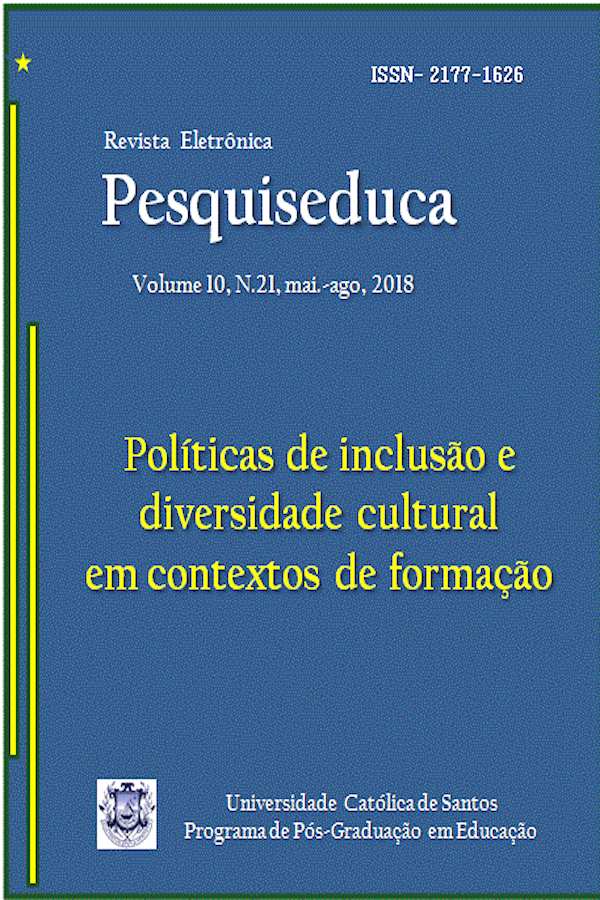Excluir incluindo ou incluir excluindo: diário de campo em uma escola inclusiva
Palavras-chave:
LGBTTT, inclusão, exclusãoResumo
Algumas das políticas públicas inseridas no Governo Federal têm como finalidade sanar questões relativas à homofobia no ambiente escolar. O Programa Federal Brasil “Sem Homofobia” foi lançado pela Secretaria Especial de Direitos Humanos (SEDH) em 2004, através do Conselho Nacional de Combate à Discriminação (CNCD). Este programa tem como objetivo combater a violência e a discriminação contra o grupo LGBT e promover cidadania homossexual, questionando temas relativos à homossexualidade em todos os Ministérios do Governo, além de propor políticas que apreciem esta população nas mais variadas esferas, entre elas a educação. No âmbito destas políticas, foi criada em Campinas-SP uma escola voltada para o público LGBT, chamada E-JOVEM. Este artigo tem como foco a investigação da realidade vivida pelos alunos desta escola, buscando verificar as possíveis transformações vividas tanto no âmbito pessoal (aprendizagem, liberdade, entre outros) quanto no âmbito coletivo, relativo ao combate à homofobia. A coleta de dados aconteceu em duas etapas: inicialmente foram realizadas observações participantes no ambiente escolar, e em seguida foram realizadas entrevistas semi-estruturadas com docentes e discentes da escola. Os resultados preliminares apontam que afirmar-se gay ou lésbica é dizer, a princípio, que não viverá segundo o natural e o convencional, que irá experimentar uma forma nova de casamento e família, que não a esperada por pais, tios, avós, etc. Quem se assume homossexual espera apoio, amor, aceitação e respeito, é nítido esse anseio por parte dos alunos. Assumir-se homossexual é correr o risco de se tornar estrangeiro, de desabrigar-se, de ir para a vida lutar pela própria sobrevivência.
Palavras-chave: Homofobia; Educação ;Políticas públicas; Desenvolvimento humano e social; Desenvolvimento como liberdade.
To exclude by including or to include by excluding: field journal in an inclusive school
Some of the policies incorporated in the Federal Government are intended to remedy homophobia in the school environment. The Federal Program “Brazil Without Homophobia” was launched by the Special Office for Human Rights (SEDH) in 2004, through the National Council for Combating Discrimination (CNCD). This program aims to combat violence and discrimination against LGBT citizens and promote homosexual citizenship by questioning issues related to homosexuality in all governmental ministries and proposing policies aimed at this population in various spheres, including education. Under these policies, a school called “E-JOVEM” and established in the city of Campinas, State of São Paulo, was designed for an LGBT public. This research project investigated the reality experienced by the students of that school in order to verify the possible transformations on a personal level (learning and freedom, among others) and on a collective level (e.g. by combating homophobia). Data collection took place in two stages: initially the school environment was participantly observed, then a field journal was conducted. Preliminary results indicate that defining oneself as gay or lesbian is to say, at first, that one will not live according to what is natural and conventional, and that will experience a new form of marriage and family, which is not expected by parents, uncles, grandparents, etc.. Those who identify themselves as homosexuals expect support, love, acceptance and respect – these yearnings are clear among students. Coming out as gay is to risk becoming alienated and unsheltered, and living to fight for one’s own survival.
Keywords: Homophobia. Education. Public Policies. Human and Social Development. Development as Freedom.
Downloads
Publicado
Como Citar
Edição
Seção
Licença
Revista Eletrônica Pesquiseduca, Revista do Programa de Pós-Graduação em Educação - Universidade Católica de Santos (ISSN: 2177-1626) é detentora dos direitos autorais de todos os artigos publicados por ela. A reprodução total dos textos em outras publicações, ou para qualquer outro fim, por quaisquer meios, requer autorização por escrito do editor. Reproduções parciais de artigos (resumo, abstract, mais de 500 palavras de texto, tabelas, figuras e outras ilustrações) deverão ter permissão por escrito do editor e dos autores.


